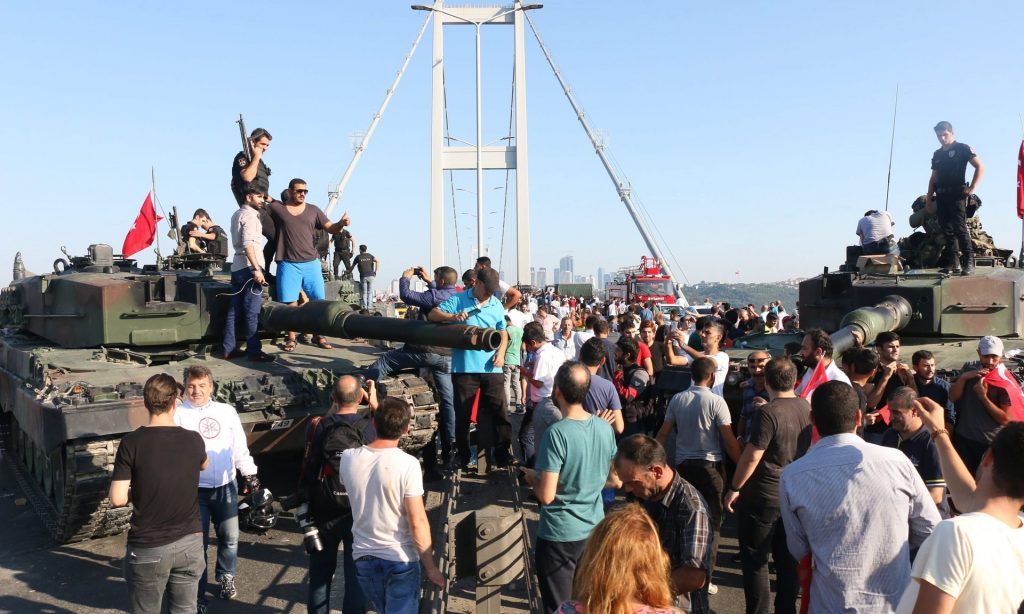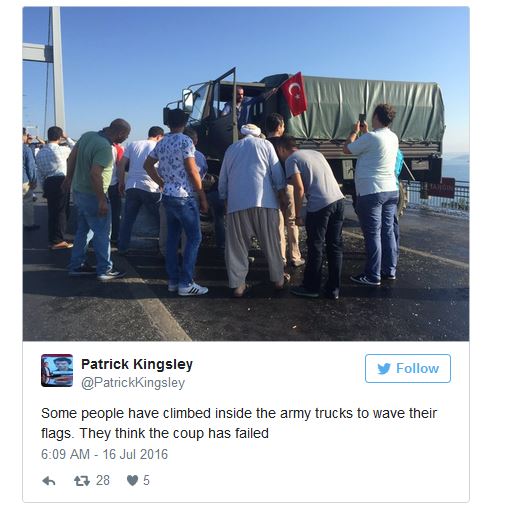
Photograph: STR/EPA
At 8am on Saturday, there were still tanks on the Bosphorus bridge. They stood on the tarmac that links Istanbul’s Asian and European shores, their turrets pointing at jaunty angles – as they had since 9pm on Friday, when their sudden appearance gave the first hint that a coup was under way.
But 11 hours later, something had changed. Gone were the soldiers who guarded the tanks. In their place were the anti-coup protesters who had chased them away. The tanks that had symbolised the start of the coup now signalled its demise.
“It’s over,” sighed Yildirim Yildiray Dundar, a 34-year-old postman, who said he had squared up against the soldiers all night to protest against the attempted coup. “That’s the end.”
It was loyalist policemen who now sat atop the tanks, waiting for a heavy-duty tow-truck to cart the tanks away. The soldiers surrendered an hour before, abandoning their positions with their hands held above their heads. It was a humiliating acknowledgment that the country had largely rejected the coup – after loyalist troops suppressed most of the revolt; secular opposition leaders stated their support for Turkey’s Islamist-minded president; and anti-coup protesters hit the streets out in their thousands.
On the Bosphorus bridge, there were scenes of delirium. Demonstrators boarded an abandoned army truck, waving Turkish flags and chanting against the coup. Cars and mopeds drove past, honking their horns in victory. “The English would never be able to do this, but we did,” one woman screamed at a pair of foreigners. “We’re Turkish.”
Then there were the conspiracy theorists. Even among the delirious victors on the Bosphorus bridge, you could find people who thought it was all a put-up job to make people more sympathetic for the autocratic President Erdoğan.
“It seems like a coup, but I don’t think it was,” said Suleyman, a 37-year-old printer. “If there was a real coup, the internet should be off, the electricity should be off. So for me it was theatre.”
For most on the bridge, however, everything was deadly real. “We would give our lives for our country,” the shouting woman continued, to roars of approval from the crowds. “We would die.”
Elsewhere in the country, at least 47 civilians had died, as protesters clashed with the instigators of the coup, and sometimes swarmed military vehicles. Some of the clashes ended peacefully, with loyalist policemen and journalists filmed capturing rebel soldiers after the latter tried to take over a television station.
Pictures also circulated of mutilated corpses, the remains of those who were allegedly mowed down by tank missiles in Ankara. Helicopter gunships were filmed shooting at protesters, while the parliament was left a blackened wreck by overnight blasts. One unverified photograph appeared to suggest that a rebel soldier had been decapitated.
On the Bosphorus bridge, there was nothing as visibly violent. But many of those who stayed overnight had bloodlust for those who tried to drag Turkey back into its coup-splattered past; the army ousted four different civilian governments between 1960 and 1997, an era that many hoped had ended.
“They should be executed straightaway,” Dundar said as he walked triumphantly from the bridge, minutes after it was finally reopened. “For the safety of all of us they need to be executed.”



One Response
160 people dead just to achieve regime change. Pray tell is it the carrion that will be ruled as blood flows in the streets?